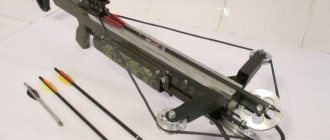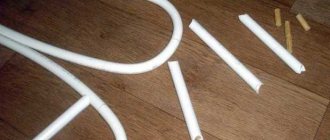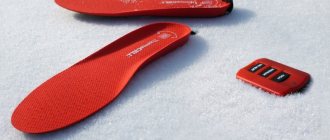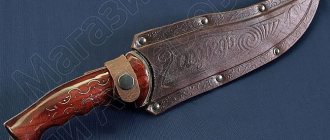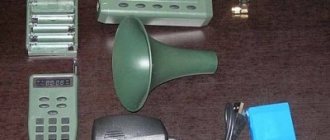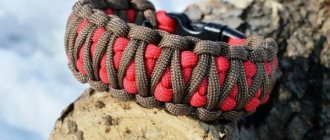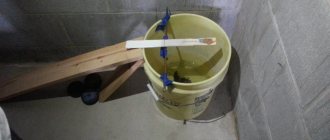Important formalities
Young people aged 12-20 years are mainly interested in making a crossbow. And here it is important to understand that the thematic product is a small weapon that can be used:
- Upon reaching adulthood;
- For sport or recreational shooting purposes;
- In a shooting range or places remote from urban infrastructure;
- For hunting, if you have two permits - to own a thematic weapon and to use it for the purpose of hunting game.
Of course, it’s always easier to wait until you reach adulthood or buy a crossbow along with documents through friends.
However, our people do not look for easy ways and most of them like to take initiatives with enthusiasm. Therefore, do-it-yourself crossbows at home are already a common topic among gun fans.
Eventually
Making your own crossbow arrows is an excellent solution in terms of saving money. However, in order for homemade projectiles to be used not only for entertainment, but also for hunting, it is necessary to try to make the shaft parts as even as possible. Even the slightest curvature increases the likelihood that the arrow will be pulled to the side.
Particular attention should be paid to the tip. The heavier this element turns out to be, the greater the penetration ability of the arrow, not to mention the improvement in the smoothness of flight.
Required Tools
The crossbow combines wooden and metal parts. Therefore, to make it you will have to have on hand:
- Chisel - for creating channels and holes in wood;
- A long ruler and a square - to take measurements;
- Mallet - for beating with a chisel;
- Carpenter's knife - to make markings;
- Metal hacksaw – for sawing metal parts;
- Pliers - to hold and straighten parts, tension and bite off springs;
- Screwdriver - for attaching metal parts to a supporting wood base;
- Chisel - to chop metal;
- Hammer - for hitting a chisel;
- Metal files - to smooth the surface of the metal;
- Wood files – for processing forests;
- Drill - to make holes in metal parts and wood workpieces.
You will also have to allocate a well-lit place with a workbench for thematic work. Moreover, the latter must have a vice that helps to efficiently fix various products. A stand for a drill, a grinder, and an electric jigsaw for wood will come in handy.
As a result, more money will be spent on tools and a machine than on solving the problem of how to make a crossbow with your own hands at home. But the target audience usually already has thematic inventory. Besides, no one is about.
Crossbow design
At first glance, a crossbow is a simple bow with a supporting base. In fact, its design provides:
- Shoulders – bow for stringing arrows;
- Block - an element for attaching the shoulders to the stock;
- Bowstring - a tensioned support for arrows;
- Guide – channel for fixing the boom;
- The trigger mechanism is a means of controlling the shot;
- The stock is a supporting frame for all of the above elements, as well as the basis for a comfortable grip of the crossbow.
Depending on the user's requirements, the crossbow can be supplemented with a stirrup, sight, forearm, butt, and belt. But first it is better to limit yourself to the basic kit.
How to choose the right arrows for a crossbow?
The main factors that influence the cost of crossbow arrows and accordingly determine the criteria for their selection are the material of manufacture, the manufacturer and the length of the products. Today, any gun store sells arrows for bows and crossbows. Experts recommend buying products from well-known manufacturers. For example, Poe Lang, Man Kung and Carbon Express products are very popular among hunters and crossbow shooting enthusiasts. Products from recognized brands are guaranteed to have high performance characteristics: rigidity along the entire length of the arrow, optimal weight distribution, and tail feathers precisely selected in terms of weight and shape. Types of crossbow arrows
Depending on the material, products are divided into the following types:
Carbon arrows. The material is distinguished by increased strength and rigidity characteristics, which are superior even to steel analogues. At the same time, carbon retains its lightness and uniform dimensions during long-term operation. However, when using such products, you should remember that carbon is a fragile material. The surface of the arrows can become covered with microcracks if you shoot at a hard surface. To give the products greater strength, carbon fibers are sintered in layers, each time changing the angle of direction of the threads. Such an arrow is almost impossible to break, which ensures high stability of the material. Aluminum arrows. These products belong to the budget group of crossbow ammunition. The main disadvantage is that the material is highly susceptible to deformation, so arrows made from it are suitable for recreational shooting. Fiberglass arrows. The main advantages of these products are high strength and low weight. This composite material is 6–7 times lighter than steel, but is not much inferior to it in strength characteristics. Fiberglass arrows retain their linear dimensions for quite a long time. The disadvantages include a non-replaceable tip. In addition, low weight can cause unwanted damage to the crossbow.
Arrows made of aluminum and fiberglass are ideal for recreational shooting or hunting birds and small animals. Carbon products are suitable for small predators, as well as for game birds. To go after a large animal, you need to acquire arrows in a metal braid.
Crossbow arrows are also used for sports and hunting. The main difference between an arrow for hunting is its long fletching, which allows it to fly faster and hit the target more accurately. Another advantage is the constant readiness of such ammunition for firing. Sports arrows are fired hollow inside, which reduces their weight and increases flight speed. The fletching of such products is shorter than that of hunting arrows, so they require time and distance to stabilize in flight.
The most popular among Russian hunters are crossbow arrows from the 16-inch size segment. Such carbon ammunition is characterized by very high strength, excellent geometry and is suitable for many mass-produced crossbow models. They also often use 20-inch arrows for hunting, which are a little more expensive, although they fly more consistently.
Short ammunition has a higher launch speed, but less penetration. Therefore, they are used for hunting small animals or birds. Long arrows do not have the highest flight speed, but they have a fairly high shot power. With carbon or steel ammunition 20-22 inches long, you can go at a medium and even large predator.
The tip of a hunting arrow usually has three steel blades. Some manufacturers produce crossbow ammunition with detachable tips so that the hunter can change individual blades if necessary.
Making onions
Many are in a hurry to make a stock, although in fact, first of all, you need to take the crossbow’s shoulders with your own hands. They are a strip of metal that is attached to the front edge of the stock to give it the appearance of a bow.
The shoulders are made in the following way:
- A 650x100 mm plate is cut out of 5-8 mm spring steel;
- Three holes are made in the center of the workpiece for attaching it to the end of the stock;
- The workpiece is polished and leveled;
- Rollers are attached to both ends of the plate to smoothly tension the boom.
Moreover, the rollers must be pre-built into the supporting housings. But if the string is short, then it can not be threaded through the rollers, but traditionally attached to the ends of the bow by winding.
The thicker and smaller the shoulders, the more difficult it is to pull them. But the speed of the arrow's flight and its penetration potential increase. True, you should not chase the corresponding indicators, because the block and the entire fastening system will bear a large load.
Tips
When selecting material for making tips, it is recommended to give preference to sheet metal with a thickness of about 0.7 mm.
This base is easily divided into the required sections using ordinary scissors. When finalizing the material, you can use a grinding stone or file. If you have access to a lathe, when making crossbow arrow tips it is much more convenient to resort to its use than to process metal manually. As a result, you can get heavier and sharper products that have increased penetration ability.
As soon as the tips are ready, you should begin installing them on the shaft. To do this, it is enough to cut grooves of the appropriate thickness at the end of the rods. The prepared openings must be generously coated with glue, the tips must be inserted, and then the connection must be secured with a tight winding of thread.
Making pads
The block is an element that presses the shoulders to the stock, i.e. fixing the bow and responsible for its reliability when pulling the arrow. Depending on the design ideas of its manufacturer, the block comes in different shapes. In this case, the requirements for the block are the same:
- Firstly, the element must consist of 8-10 mm steel;
- Secondly, the block should press the shoulders to the stock in the center, on the sides and even on top;
- Thirdly, the arrow must fly out through the block, so the first one comes with a hole or opening.
Often the block consists of several plates. The main thing is that they are not too heavy. Otherwise, the crossbow will be difficult to use, because he will be mowed down with each shot. And if this is a mini-crossbow with your own hands, then it will be completely inconvenient for a normal grip.
Note!
Do-it-yourself compressor: selection of materials and tools for assembly at home + step-by-step instructions for making and assembling yourselfHomemade products for the garage with your own hands: options for products for arranging a garage, detailed diagrams and drawings for creating with your own hands
Do-it-yourself press - design features, choice of manufacturing materials. Step-by-step instructions for making it yourself + simple diagrams and drawings
Hunting and sporting arrows for crossbows
The type of arrow largely determines such parameters as accuracy, accuracy and range of the crossbow. For each specific crossbow model, you should select the appropriate type of arrows. In addition, the durability and trouble-free functionality of the crossbow's throwing equipment depends on the correct choice of arrows. Ammo for crossbows differs significantly from arrows for bows, whether recurve models or more powerful compound bows. Crossbow arrows are shorter and stiffer than bow arrows and exhibit the greatest accuracy and stability in flight.
The influence of arrow characteristics on accuracy and firing range.
An important parameter when choosing ammunition for a crossbow is the weight of the arrow (bolt). Arrows that are too light will quickly damage the moving mechanisms and bowstring of a crossbow, since the energy parameters and impact load in this case are many times greater than the capabilities of the ammunition. Arrows that are too heavy will accelerate wear on the bowstring (ropes) and fatigue on the crossbow's shoulders.
Unscrupulous sellers offer supposedly “licensed” Chinese products for branded crossbows of the brands Excalibur, Hoyt, Barnett, etc. However, we should not forget that the slightest deviation from the characteristics recommended by the manufacturer will lead to the failure of expensive weapons. In addition, the quality of shooting with such ammunition leaves much to be desired, and if you miss while hunting or exciting games, you only have yourself to blame.
In order not to be disappointed in this interesting hobby, we recommend purchasing ammunition produced by world brands:
- Easton
- Interloper
- Carbon Express
By purchasing branded products, the owner of a crossbow can be sure that all the ammunition he uses will be of the same weight, length and rigidity, with the appropriate fletching and correct balancing.
Depending on the materials, technologies and purpose used for manufacturing, crossbow ammunition is divided into certain types and has its own advantages and disadvantages:
- Carbon arrows are the most popular, but over time they become covered with microcracks when carelessly shooting at hard targets. Therefore, it is recommended to use less expensive ammunition for training, and carbon only for hunting or competitions.
- Arrows made of aluminum alloy are in second position in terms of cost. The main disadvantage of this ammunition is that it becomes deformed after several shots. Recommended for hunting (with new arrows) or for shooting at regular and 3D targets.
- Fiberglass arrows are cheap, budget-friendly crossbow ammunition. They are used only on low-power weapons, since they are too light and can damage the bowstring, cables (for block crossbows) and weapon mechanisms.
Also, crossbow ammunition is divided into two main groups:
- Sports arrows are usually tubular (hollow) products with the lowest possible weight, making them the fastest and longest-range. Used for sport and recreational shooting.
- Hunting arrows are produced only as solid cast arrows, since they must be 2 times heavier than sports arrows in order to provide the greatest impact force to inflict a mortal wound on the animal. In this case, the flight range fades into the background.
How to Choose the Right Ammo for Effective Hunting
Big game can only be hit with a heavy carbon arrow - it is an extremely durable, highly effective ammo with perfect balance and geometry and thickness along its entire length. Often, on crossbow ammunition intended for hunting, the front section of the shaft is equipped with a threaded insert onto which you can screw a tip appropriate for the intended purpose - sporting or hunting.
Fletching used for hunting and sporting arrows
Carbon ammunition for hunting any animal, be it a hare or a bear, is always equipped with a longer tail than for sport shooting. The fact is that effective hunting of a large animal can only be achieved from a distance of no more than 30 meters to the target. Thus, an arrow fired from a crossbow must stabilize within the first 5-10 meters and take a combat course in order to hit the target to death.
Aluminum and fiberglass ammunition are more suitable for training and sports shooting at “soft” targets. But with them you can hunt birds and small animals well. These arrows are shorter and less heavy than carbon arrows for big game. The length of such ammunition is up to 30 cm, weight +/– 25 grams.
Tips for hunting and sporting ammunition
For hunting, it is necessary to use tips with sufficient penetrating power and high lethality. For 100% lethal defeat of an animal, different types of tips are used, depending on the size and weight of the expected game.
There are three main categories of hunting tips:
- Shockers with a blunt tip that prevents penetration and damage to the skin,
- Streamlined, with blades opening in the body of the beast,
- All-alloy with fixed blades.
Experienced hunters carry sets of ammunition with various types of tips for hunting any animal.
Making the trigger mechanism
One of the complex processes is working with the trigger mechanism. The fact is that it is a set of several steel parts:
- Trigger;
- Sear for holding the bowstring;
- Two springs for fixing the hook and sear;
- Two plates for the supporting body;
- Bolts and nuts.
Usually crossbow drawings show only the closed trigger mechanism without a detailed description of it.
A 6mm steel sheet is used to make the hook, sear and plates. But before sawing it, it is recommended to draw each detail on a piece of paper and then cut it out.
By placing paper pieces on a sheet of metal, it will be easier to cut the latter with a grinder or hand saw. Moreover, the workpieces must be sawed so that they have a 2-mm margin at the edges, which can be ground off with a file.
After the workpieces are ready, holes for fasteners must be drilled in the plates. Next, a hook with a sear is placed on top of one body plate.
Note!
- Do-it-yourself winch: classification, manufacturing materials, description of work stages + instructions for DIY construction
Do-it-yourself clamp - step-by-step production and description of options for using a clamp
DIY knife | A step-by-step description of how and from what materials to make a homemade knife
The next step is to tighten the moving elements with two springs. After this, you need to make sure that the trigger mechanism is working and close it with a second strap.
Ballistics of crossbow arrows
There are two main factors influencing ballistics - the weight and stiffness of the arrow (of course, provided that the arrows themselves are straight). Everything is clear with the first one, since it is reflected in the fundamental formula E = mv2/2. That is, both speed and energy depend on the mass of the projectile. All this significantly affects the flight trajectory, and therefore the accuracy of the hit, the calculation of aiming corrections, the firing range, etc. It doesn’t matter whether it’s a bow, a crossbow or a rifle.
This is what the real speed indicators of one crossbow with original and GOST shoulders look like for various arrows:
| Crossbow model/ tension, lbs | Initial speed fps / m.s., with arrow weight (average value over 3 shots) | ||||||||||
| 390 grains | 408 grains | 433 grains | 450 grains | 470 grains | 485 grains | 500 grains | 565 grains | 590 grains | |||
| "Archon" | 200 lbs/91 kgf | 369,9 / 112,8 | 360,6 / 109,9 | 350,9 / 106,9 | 344,7 / 105,0 | 337,3 / 102,8 | 330,8 / 100,8 | 329,4 / 100,4 | 312,1 / 95,1 | 306,4 / 93,4 | |
| "Archon" | 95 lbs/43 kgf | 267,4 / 81,5 | 259,2 / 79,0 | 253,0 / 77,1 | 249,0 / 75,9 | 244,7 / 74,6 | 240,2 / 73,2 | 239,3 / 72,9 | 226,8 / 69,1 | 221,9 / 67,6 | |
Necessary explanations for crossbow-bow units of measurement:
1 Lbs (lb) = 0.45 kg
1 grain = 0.0648 grams
1 fps (feet per second) = 0.305 m/s
The issues of dependence of arrow speeds on the types of arms and other factors are discussed in more detail in the article “Powerful crossbow - what kind of animal is this?”
For uniform ballistics and, therefore, high accuracy, all your arrows should be the same. Uniformity will also help avoid additional shooting. With an average weight of an arrow with a tip of about 25 grams (390 grain), we are talking about tenths of a gram. Almost any household electronic scale can easily cope with such measurement accuracy.
Much more difficult with rigidity. An arrow is not a bullet; in flight it wriggles like a snake. This phenomenon is called the “arrow paradox” and is often played out in Korean and Chinese historical action films, when on the screen in slow motion arrows manage to cleverly go around “their own” and hit the enemy. We will dwell on it in detail in the article about archery arrows, since it is difficult to do without adjusting the rigidity (“spine”) to a specific bow. “Spine” is the amount of arrow deflection in fractions of an inch. For example, with a spine of 400, the value is 0.400 inches (2.54 cm).
In short, the spine measurement technique looks like this:
The load must be a certain weight (880 g), the boom must be 29 inches long, etc. The smaller the “spine” - the amount of deflection of the arrow - the stiffer it is. The length of the arrow, the weight of the tip and shank, the strength of the bow, and much more are also taken into account.
For a crossbow, this factor is not so significant. The fact is that a crossbow arrow is much shorter than a bow arrow and in any case, even with relatively thin walls of the “tube”, will be stiffer (archers cut the tubes to increase rigidity). In addition, unlike any bow, it moves along a guide groove. And yet, “spine” cannot be completely discounted. Simply put, the more powerful the crossbow, the stiffer the arrows should be. And the larger the animal you are going to hunt, too. As, by the way, is the total mass of the arrow with a combat tip, even if the speed decreases slightly.
We are only interested in uniformity in rigidity. The simplest and only way is to purchase arrows from well-known manufacturers and not bother with anything else. Moreover, for them, the “firms” always indicate both the mass and the “spine”. It is very difficult to correctly measure the spine of a short crossbow arrow at home; you can bend it or break it.
A few words about digital indexes. For example, let’s take one of the most popular and widespread arrows with the index “2219”. So, the first two numbers indicate the outer diameter of the boom in 1/64ths of an inch, and the second two indicate the thickness of the tube wall in thousandths of an inch.
As for the material. These are fiberglass, aluminum and carbon. We won’t consider the first one at all – well, to hell with it. When choosing expensive branded arrows, there is no particular difference - whether they are aluminum or carbon. Among cheap products from Southeast Asia, it is better to choose carbon. I’m not an expert in the Technology of Structural Materials, but I think that carbon in production is more technologically advanced and makes it possible to achieve better performance at lower costs.
In general, it wouldn’t hurt to have a special machine to detect the curvature of arrows and defects in tips. It costs about the same as one good assembled hunting arrow.
Finally, we move on to the arrows themselves. Let's start with the entertainment and recreation segment.
Making a stock
The stock is made from solid wood, which is very easy to process. Moreover, the supporting part may have a butt for conveniently attaching the stock to the shoulder or a slightly convex edge with slots through which you can stick your hand to hold the handle of the crossbow with your hand.
Each user of a themed weapon chooses the shape of the stock for himself, guided by its convenience and the size of the workpiece. Therefore, solving the problem of how to make a crossbow with your own hands cannot be done without sequentially making a stock:
- First you need to draw a sketch and draw a drawing;
- Next, transfer the dimensions from the sheet of paper to the forest area;
- Cut out the workpiece;
- Adjust the size of the workpiece according to the sketch and drawing.
For fitting, the workpiece is compressed in a vice and leveled using a file and sandpaper. First you need to use a coarse-grained base, then a fine-grained one.
The main thing is that the workpiece does not touch the jaws of the vice. Otherwise, the latter will leave a mark on the surface of the array. This can be avoided by placing rags or planks in advance between the jaws of the vice and the workpiece itself.
Note!
DIY vices: simple and reliable homemade vices from A to Z (190 photos)Do-it-yourself vibrating table - selection of materials, components and assemblies for a vibrating table with a step-by-step manufacturing description
Do-it-yourself grain crusher - operating principle, types and features of creating a device for processing grain crops
You can make a crossbow with your own hands at home, if there are no logs nearby, using a 30x50x6 cm board. This lumber must be made of durable species - oak, hornbeam, walnut, pear.
But the first experience is easier to obtain using easily processed pine. In the end, the crossbow is repairable, and this feature is facilitated by the ability to replace the stock.
When the stock is ready, you need to make a large recess in it for the trigger mechanism, as well as holes for the block with shoulders. The corresponding parts are attached to the stock, after which you can begin making the guide and bowstring.
Preparation of the pole part
To make reliable arrows for a crossbow, saving on materials, it is enough to take pine as a basis, since such a tree is extremely common in domestic latitudes and is easy to process.
It is recommended to use dried wood. The length of the shaft will depend on the parameters of the existing crossbow. As for the diameter of the rod, the optimal solution in most cases is a value of approximately 1 cm.
After marking the workpiece, you can proceed directly to its processing. For rough trimming, it is enough to use a carpenter's plane. For fine processing, use a sharp knife with a thin blade.
How to make arrows for a crossbow in such a way that their flight is extremely precise? To do this, during the manufacturing process it is necessary to ensure that the rod remains as straight as possible. After roughing is completed, it is worth walking over the surface several times with coarse sandpaper. Finally, it is necessary to thoroughly polish the surfaces of the shaft part.
In order for crossbow arrows to retain their original shape, it is extremely important to protect them from moisture. To do this, surfaces can be coated with wax or other material with water-repellent properties. It is most convenient to carry out processing using a regular sponge or a piece of soft cloth.
Making a guide
The guide is usually called a metal strip into which the arrow goes deep and along which it slides during the shot. Accordingly, the bar must be straight and smooth so that the arrow does not squint with each shot.
Before you start making the guide, you need to cut a channel under it with a chisel, 1.5-1.8 cm wide and 1.5-2.0 cm deep. It is cut at the top and in the middle of the bed.
The channel begins in the area of the hole for the trigger mechanism and ends at the edge of the stock - next to the block. The depth of the channel around the entire perimeter must be the same so that the guide sits evenly everywhere on the crossbow; drawings from a spring, which look no less complex than from a guide.
Next, a strip in the form of a metal profile pipe without one wall is immersed into the channel. The plank must be completely submerged so that the edges of its sides do not protrude outward. Also, the guide should not dangle, so the dimensions of the channel are adjusted precisely to it.
To fasten the strip to the channel, you can drill holes for screws at the bottom of the first one. But the caps of the screws can interfere with the arrow, so the guide is often fixed with epoxy glue.
Making a bowstring
You can check the balance of the level of the shoulders and the guide, the smoothness of the trigger mechanism and the tightness of the rebate of all fasteners only by tensioning the bowstring on a homemade crossbow with your own hands. It is made in the following way:
- Two self-tapping screws are screwed parallel to each other into a long board at a distance of 50 cm from each other;
- Two self-tapping screws are wrapped with waxed linen rope four times on each side so that eight threads are formed between them;
- The four strands in the middle are wrapped with waxed rope to form a rigid 8cm base;
- The previous winding is done with the remaining four threads;
- One rigid base is put on one self-tapping screw, the other threads are twisted so that they intertwine with each other;
- After weaving four threads with the other four, the second rigid base is put on a self-tapping screw, and the resulting cable is wrapped with thread to finally fix the braid.
The string remains to be cut into the shoulders. But if the latter include rollers, then the rope for making a rigid cable should be 2.5 times longer. Moreover, you will have to wrap only four threads, not eight. After all, the finished bowstring will have to be inserted into the narrow slots between the rollers and their bodies.
Making arrows
Crossbow arrows are called bolts. This is explained by the fact that they come shortened - 16 inches versus 29, as different do-it-yourself crossbow videos demonstrate. The diameter remains the same - 6-9 mm. The arrow itself is divided into three parts:
- Tip;
- Bearing rod;
- Plumage.
For the manufacture of rods, it is necessary to use exclusively durable wood, the diameter of which is close to the diameter of the directly supporting base. To make the workpiece round, you will have to:
- Clear the stick of bark and excess wood;
- Insert the workpiece into the chuck of a drill or screwdriver;
- Start the power tool holding it with one hand;
- Grasp the open part of the workpiece with sandpaper and move it from one end to the other to sand the surface.
The output will be a smooth rod, which remains to be completed with a tip and feathering.
Wide tape is used for the plumage. You need to cut two small rectangular sections from it in order to wrap these sections around a round rod. After wrapping, the tape is carefully pressed, and the edges are trimmed to the shape of the feathers.
It is easier to assemble the tip from a triangular tip and a tube by welding these metal elements to each other. For welding, you can use an inverter with electrodes or a gas lighter with solder.
The result is a crossbow capable of hitting a target at a distance of 20-40 meters. Accuracy can be improved by mounting the rear sight on top of the trigger mechanism. More experienced shooters supplement their crossbows with optical sights or collimators.
